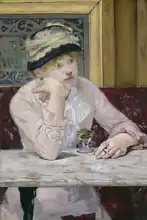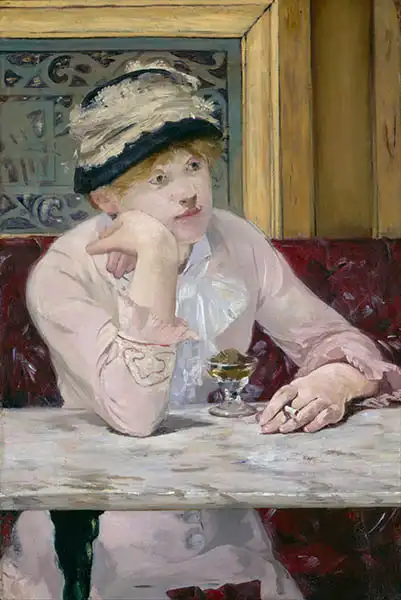About this finishing
Print. The image is printed on the top quality 10-ink HP Z9PS printer on HP matte 270 g / m2 paper. You can choose any size to an accuracy of 1 cm. A margin of 5 cm around the image is added to the size of the motif.


You can find a detailed description about our finishings
here.
Plum
Date:
1878Medium:
oil on canvasLocation:
National Gallery of Art, Washington DC, USADimensions:
73.6 x 50.2The painting shows a woman sitting at a table indoors. The woman is wearing a pink blouse and a white hat with a black belt. She is leaning on her elbow and appears to be gazing thoughtfully into the distance. On the table in front of her is a glass, presumably containing an alcoholic beverage. The whole scene gives the impression of a contemplative atmosphere and calm. The painting has an impressionistic character with visible brushes and nuances of colour.
This description was created by artificial intelligence, please be indulgent.
Manet painted picture Plum in 1878. Prevailing color of this fine art print is vivid and its shape is portrait. Original size is 73.6 x 50.2. This art piece is located in National Gallery of Art, Washington DC, USA. This image is printed on demand - you can choose material, size and finishing.
Édouard Manet (1832-1883). French
Impressionist painter. He perhaps had the misfortune of starting at a time when the pendulum of history was deviating from traditional academic painting and Impressionism: for his generational peers, he was too progressive and for young painters, he was too traditional. Manet had an innovative spirit that, during his study of old masters (such as
Diego Velázquez), he complemented with an excellent painting technique. From the Impressionists, he took a penchant for displaying reality using long expressive brush strokes, studying objects in the open air, and concentrating on working with light and colour. Unlike the Impressionists, however, he did not give up black colours, contours and classical composition. In fact, he did not even want to be associated with the Impressionists – he wanted his paintings to be included independently in Salon exhibitions and avoided the label of
Impressionism.


